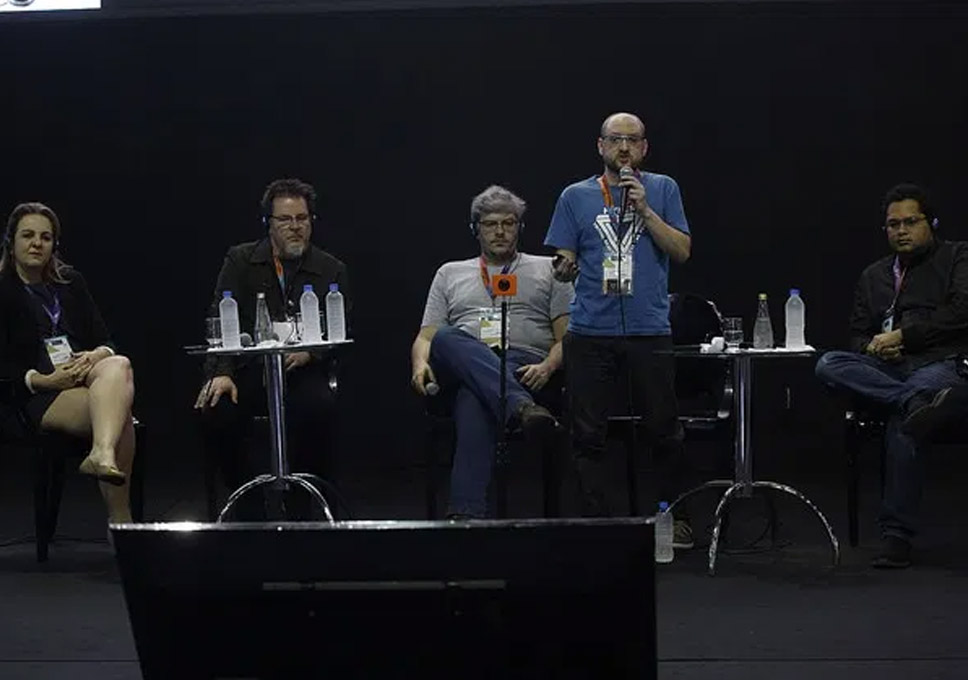Tela Viva on 31/08/2018
For years, the market has heard that virtual reality will conquer the audiovisual sector and revolutionize the ways of production. But for now, this so-called technology boom is still om dress rehearsal and, at least for the final audience, that story is still a long way away. The producers of VR, augmented reality (AR) and mixed reality form a very concentrated chain – so much so that they have joined together to form XRBR, an immersive content connection hub. Tadeu Jungle, from Junglebee; Fabio Hofnik, from Hyper VR; Mario di Pol, from Input; Karina Israel, from Ydreams Global; and Rodrigo Terra, from ARVORE, are all members of the hub and met this Thursday, 30, at Max 2018, in Belo Horizonte, to discuss the development of such content.
Fabio Hofnik is ahead of Hyper, the company that produces the largest virtual reality festival in the country, the Hyper Festival – the next edition is scheduled for October 27 this year. For him, neither clients nor public know yet what this medium is capable of doing. “We need to turn this key and understand that it is not an adaptation of movies or games, but the creation of a new business, the establishment of an unprecedented market and the adoption of another language”, he pointed out. About this, Mário added: “There is no media space as convergent as virtual reality.” In other words: the options are so many that the big challenge is not to produce, but to reach an understanding of the market in view of these new possibilities. “It’s much more about what we don’t know than what we know.”, he added.
Despite this, the few who invest in this market are growing and standing out. Tadeu Jungle is an example. This year, he, who came from the arts and “traditional” audiovisual, opened Junglebee, a production company specializing in immersive content. Jungle is very optimistic about the industry’s path: “The world of VR is imminent. We just need to know ‘when’ and ‘how’ it will settle down, not ‘if’ it will. New technologies will be relentless and dominant.” But he joked: “Virtual reality is not a magic lamp.” Tadeu says that it is very common for him to receive clients in the studio with daring and even exaggerated briefings, precisely because of this lack of clarity identified by Hofnik and di Pol. “It’s important not to stray from the premise that storytelling is the main thing. And that goes for everything: cinema, advertising, television. Technologies change every day, while stories remain,” he argued.
Karina Israel, from Ydreams Global, recently opened a division within the company focused on interactive architecture, with environments such as museums and exhibitions created for brands. She identifies another challenge: getting out of the equipment. “I get many customers who come with stock ideas just thinking about VR glasses. It has to go beyond that. The path in this medium is walked backwards. I always ask them: What do you want to feel? What emotion do you want to cause in the end? It is from there that we will develop the story,” she said.
The group agrees that the question of risk may still be a point that is blocking the possible explosion of mixed reality in the market. According to di Pol, starting to work with this takes courage, because everything works on the basis of ten attempts, nine mistakes and one hit. “The risks are high and are part of the process, but the results of the experiences that do work are highly positive,” he added. And, finally, he was assertive: “We are designing a new category and, normally, whoever designs a new category tends to dominate it. We are blazing through an unknown path. We’re going to create new jobs and produce completely new things.”
